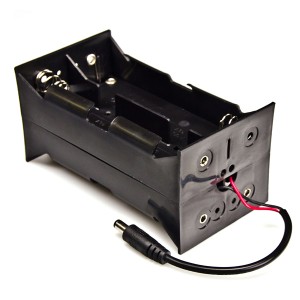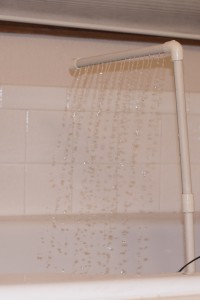Bathtub Waterworks

World Class Watermessing
| Part | Cost |
|---|---|
| Small low voltage water pump | $25 |
| 8 D cell battery box or 12v wall wart | $9 |
| Selection of 1/2 inch CPVC fittings | $15 |
| Some wire (speaker wire or whatever) | |
| Drill and some small drill bits | |
| Some kind of saw or pipe cutter | |
| Zip ties | |
| TOTAL | ~ $50 |
In my family we always called it water-messing, and I believe it to be one of the great joys set deep in the spirit of humankind. Perhaps the best known water-messer of all time was Archimedes of Syracuse who, according to the legend, founded hydrostatics one afternoon while splashing around in the tub. The God of the universe Himself is reported to have spent only the second day ever to have existed in time and space with His mighty hand mightily applied to some literally cosmic water-messing.
I remind myself of these considerations whenever I start feeling ridiculous for enjoying this toy at least as much as my pint-sized hydrodynamicist does.
This kit can break down to fit in a toolbox and is also great fun on water tables and in swimming pools.

Pump
I had the pump I used laying around from a previous project, but there are plenty of good candidates on ebay. Any submersible 12v pump with a power consumption in the neighborhood of 1 amp (12 watts), and at least two or three meters of static head pressure will be great. If you can find one with 1/2″ pipe thread ports it will be even easier to use. There are dozens of models around for things like fountains and liquid cooling for computers. At the time of this writing you can find a perfect fit by searching for DC40C 1230 on ebay.

Power
This is water and electricity, but that is why we are using such a low voltage pump. If you use a 12v plug-in power supply, please be very sure you only plug it in to a GFCI outlet, and that you test the outlet’s GFCI, every time, before you do. The chances of a high voltage leak getting all the way in to the bath are very remote, but still possible, so don’t take chances on the outlet. If you are going to use a plug-in power source, find a bottle of liquid electrical tape in the wiring section of your local hardware store and give any exposed connections a coat or two.
If you aren’t completely sure what all of that means or want to be completely safe, use a battery pack. Google “8 D cell battery box”. 8 D cells will run a pump like this for a total of a day or two, and there is no risk of shocks. You also wont really have to worry about waterproofing your wire joints, but they will slowly corrode if they sit around under water with the power on, and it certainly won’t hurt.
Fittings
If you got a pump with threaded ports, get a CPVC thread to 1/2 inch slip converter with threads that fit the output of the pump. If in doubt, just take the pump to the hardware store with you, the guys there will make it happen. Other than that, a collection of slip connect elbows, Ts, unions, and caps makes for plenty of plumbing fun. Usually the hardware store has bags of 10 for a big discount over individuals. We drilled holes along pipes and in fun places in the caps to make for fun water sculptures.
We built a base about 10 inches square out of pipe and fittings and strapped the pump on tight with zip ties. Not my finest engineering, but its waterproof and durable. The base will have to keep your creations from tipping over when they get top-heavy, so don’t skimp too much.
Finally, chop up your pipe in to various sizes. It seemed like a few in the 10 or 12 inch range was plenty, after that we mostly use 2 and 3 inch sections. Wire up your pump to your power, fill up the tub, and build stuff!
More Ideas
The above parts are more than enough to keep us busy for hours, and things usually start looking pretty Seussien pretty quickly.
To add to the fun, we found that larger diameter pipe and fittings will slip and move over our smaller pipe, so they can be used to create dynamic sculptures. For example, 3/4 inch CPVC pipe spins easily over the 1/2 inch pipe we built the fountain with, so we built some spinners and paddle wheels and stuff with it.
We also picked up a cheap toolbox that fits in the linen closet for the pump and all the parts when we aren’t using it. You’ll want to stay close so that your little engineer doesn’t pump the whole tub out on to the floor, but then you’ll want to stay close just to play anyway.









Leave a Reply